Pashtunistan
Pashtūnistān (Pashto: پښتونستان; also called Pakhtūnistān,[4] or Pathānistān,[5][6] meaning the "land of Pashtuns")[7] is the geographic historical region inhabited by the indigenous Pashtun people of modern-day Afghanistan and Pakistan, wherein Pashtun culture, language, and national identity have been based.[8][9][10] Alternative names historically used for the region include "Pashtūnkhwā" (پښتونخوا) and "Afghānistān" (افغانستان), since at least the 3rd century CE onward.[4][11][12] Pashtunistan borders Iran to the west, Persian and Turkic-speaking areas of Turkestan region to the north, Kashmir to the northeast, Punjab to the east, and Balochistan to the south.[13]
Pashtunistan پښتونستان | |
|---|---|
 Pashtun-inhabited regions in green (1980) | |
| Countries | |
| Population (2012) | |
| • Total | c. 42–50 million[1][2][3] |
| Demographics | |
| • Ethnic groups | Pashtuns Minor: Balochs, Nuristanis |
| • Languages | Pashto Minor: Persian, Urdu, Hindko, Balochi, Ormuri, Parachi, Dardic, Nuristani |
| Time zone | UTC+04:30 and UTC+05:00 |
| Largest cities | |
For administrative division in 1893, Mortimer Durand drew the Durand Line through Pashtunistan, fixing the limits of the spheres of influence between Afghanistan and British India and leaving about half of the Pashtun territory under British rule. This Durand Line now forms the internationally recognized border between Afghanistan and Pakistan.[14] Roughly, the Pashtun homeland stretches from areas south of the Amu River in Afghanistan to west of the Indus River in Pakistan, mainly consisting of southwestern, eastern and some northern and western districts of Afghanistan, and Khyber Pakhtunkhwa and northern Balochistan in Pakistan.[15]
| Part of a series on |
| Pashtuns |
|---|
| Kingdoms |
The 16th-century revolutionary leader Bayazid Pir Roshan of Waziristan and the 17th-century "warrior-poet" Khushal Khan Khattak assembled Pashtun armies to fight against the Mughal Empire in the region. In those times, the eastern parts of Pashtunistan were ruled by the Mughals while the western parts were ruled by the Persian Safavids. The Pashtun region first gained an autonomous status in 1709 when Mirwais Hotak successfully revolted against the Safavids in Loy Kandahar. The Pashtuns again achieved unity under the leadership of Ahmad Shah Durrani, founder of the Durrani dynasty, when he established the Afghan Empire in 1747. In the 19th century, however, the Afghan Empire lost large parts of its eastern territory to the Sikh and British Empires. Famous Pashtun independence activists against the rule of the British Raj include Abdul Ghaffar Khan (Bacha Khan), Abdul Samad Khan Achakzai, and Mirzali Khan (Faqir of Ipi). Bacha Khan's Khudai Khidmatgar movement was strongly opposed to the partition of India.[16][17][18] When the Indian National Congress declared its acceptance of the partition plan without consulting the Khudai Khidmatgar leaders, Bacha Khan felt deeply betrayed and hurt by this.[19] Despite the Bannu Resolution in which Bacha Khan's Khudai Khidmatgar movement demanded that the Pashtun-majority North-West Frontier Province (NWFP) should become an independent state of Pashtunistan, the NWFP joined the Dominion of Pakistan as a result of the 1947 NWFP referendum which had been boycotted by the Khudai Khidmatgar movement.[20][21] Bacha Khan and his brother, then-chief minister Khan Abdul Jabbar Khan (Dr. Khan Sahib), rejected the referendum citing that it did not have the options of the NWFP becoming independent or joining Afghanistan.[22][23] Later on Bacha Khan, during his stay in Afghanistan, said that "Pashtunistan was never a reality". The idea of independent Pashtunistan never helped Pashtuns and it only caused suffering for them. He further stated that the "successive government of Afghanistan only exploited the idea for their own political goals".[24] On the other hand, Mirzali Khan and his followers refused to recognize Pakistan and continued their war from their base at Gurwek, Waziristan against the Pakistani government.[25][26] Growing participation of Pashtuns in the Pakistani government, however, resulted in the erosion of the support for the secessionist Pashtunistan movement by the end of the 1960s.[27] In 1969, the autonomous princely states of Swat, Dir, Chitral, and Amb were merged into Khyber Pakhtunkhwa (previously known as NWFP). In 2018, the Pashtun-majority Federally Administered Tribal Areas, formerly a buffer zone with Afghanistan, were also merged into the province of Khyber Pakhtunkhwa (previously known as the North-West Frontier Province), connecting the regions to Pakistan proper.[28]
Origin of term
The name used for the region during the middle ages and up until the 20th century was Afghanistan. Afghanistan is a reference to this land by its ethnicity, which were the Afghans, while Pashtunistan is a reference to this land by its language. Mention of this land by the name of Afghanistan predates mention by the name of Pashtunistan,[11] which has been mentioned by Ahmad Shah Durrani in his famous couplet, by 6th-century Indian astronomer Varahamihira, 7th-century Chinese pilgrim Hiven Tsiang, 14th-century Moroccan scholar Ibn Battuta, Mughal Emperor Babur, 16th-century historian Firishta and many others.
The men of Kábul and Khilj also went home; and whenever they were questioned about the Musulmáns of the Kohistán (the mountains), and how matters stood there, they said, "Don't call it Kohistán, but Afghánistán; for there is nothing there but Afgháns and disturbances." Thus it is clear that for this reason the people of the country call their home in their own language Afghánistán, and themselves Afgháns. But it occurs to me, that when, under the rule of Muhammadan sovereigns, Musulmáns first came to the city of Patná, and dwelt there, the people of India (for that reason) called them Patáns—but God knows![12]
— Ferishta, 1560–1620
The Pashto name Pakhtunistan or Pashtunistan (Pashto: پښتونستان (Naskh)) evolved originally from the Indian word "Pathanistan" (Hindustani: پٹھانستان (Nastaleeq), पठानिस्तान (Devanagari)).[29][30][31] The concept of Pashtunistan was inspired by the term "Pakhtunkhwa".[29] British Indian leaders, including the Khudai Khidmatgar, started using the word "Pathanistan" to refer to the region, and later, the word "Pashtunistan" became more popular.[29][30]
The native people
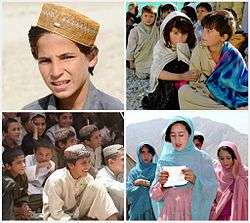
The native or indigenous people of Pashtunistan are the Pashtuns (also known as Pakhtuns, Pathans and historically as ethnic Afghans), an Iranic ethnic group. They are the largest ethnic group in Afghanistan and the second largest in Pakistan. The Pashtuns are concentrated mainly in the south and east of Afghanistan but also exist in northern and western parts of the country as a minority group. In Pakistan they are concentrated in the west and northwest, inhabiting mainly Khyber Pakhtunkhwa and northern Balochistan. In addition, communities of Pashtuns are found in other parts of Pakistan such as Sindh, Punjab, Gilgit-Baltistan and in the nation's capital, Islamabad. The main language spoken in the delineated Pashtunistan region is Pashto followed by others such as Balochi, Hindko, Gojri, and Urdu.
The Pashtuns practice Pashtunwali, the indigenous culture of the Pashtuns, and this pre-Islamic identity remains significant for many Pashtuns and is one of the factors that have kept the Pashtunistan issue alive. Although the Pashtuns are politically separated by the Durand Line between Pakistan and Afghanistan, many Pashtun tribes from the FATA area and the adjacent regions of Afghanistan, tend to ignore the border and cross back and forth with relative ease to attend weddings, family functions and take part in the joint tribal councils known as jirgas.[32] Though this was common before the war on terror but after several military operations conducted in FATA, this cross border movement is checked via military and has become very less in comparison to the past.
Depending on the source, the ethnic Pashtuns constitute 42-60% of the population of Afghanistan.[33][34][35][36][37][38] In neighboring Pakistan they constitute 15.42 percent of the 200 million population, which does not include Pashtun diaspora in other Pakistani cities and provinces. In the Khyber Pakhtunkhwa Province of Pakistan, Pashto speakers constitute above 73 percent of the population as of 1998.[39]
History
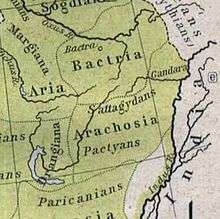
Since the 2nd millennium BC, the region now inhabited by the native Pashtun people had been conquered by Ancient Iranian peoples, the Medes, Achaemenids, Greeks, Mauryas, Kushans, Hephthalites, Sasanians, Arab Muslims, Turks, Mughals, and others. In recent age, people of the Western world have nominally explored the area.[40][41][42]
Arab Muslims arrived in the 7th century and began introducing Islam to the native Pashtun people. The Pashtunistan area later fell to the Turkish Ghaznavids whose main capital was at Ghazni, with Lahore serving as the second power house. The Ghaznavid Empire was then taken over by the Ghorids from today's Ghor, Afghanistan. The army of Genghis Khan arrived in the 13th century and began destroying cities in the north while the Pashtun territory was defended by the Khalji dynasty of Delhi. In the 14th and 15th century, the Timurid dynasty was in control of the nearby cities and towns, until Babur captured Kabul in 1504.
Delhi Sultanate and the last Afghan Empire
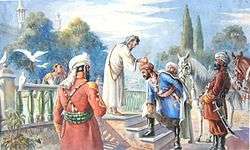
During the Delhi Sultanate era, the region was ruled by mainly Afghan and various, largely Sunni, Hanafi-jurisprudential driven Turkic[43][44] dynasties from Delhi, India. An early Pashtun nationalist was the "Warrior-poet" Khushal Khan Khattak, who was imprisoned by the Mughal emperor Aurangzeb for trying to incite the Pashtuns to rebel against the rule of the Mughals. However, despite sharing a common language and believing in a common ancestry, the Pashtuns first achieved unity in the 18th century. The eastern parts of Pashtunistan was ruled by the Mughal Empire, while the western parts were ruled by the Persian Safavids as their easternmost provinces. During the early 18th century, Pashtun tribes led by Mirwais Hotak successfully revolted against the Safavids in the city of Kandahar. In a chain of events, he declared Kandahar and other parts of what is now southern Afghanistan independent. By 1738 the Mughal Empire had been crushingly defeated and their capital sacked and looted by forces of a new Iranian ruler; the military genius and commander Nader Shah. Besides Persian, Turkmen, and Caucasian forces, Nader was also accompanied by the young Ahmad Shah Durrani, and 4,000 well trained Pashtun troops from what is now Afghanistan and North-west Pakistan.
After the death of Nader Shah in 1747 and the disintegration of his massive empire, Ahmad Shah Durrani created his own large and powerful Durrani Empire, which included Pashtunistan, Sindh, Punjab, Baluchistan and Kashmir. The famous couplet by Ahmad Shah Durrani describes the association the people have with the regional city of Kandahar:
"Da Dili takht herauma cheh rayad kam zama da khkule Pukhtunkhwa da ghre saroona". Translation: "I forget the throne of Delhi when I recall the mountain peaks of my beautiful Pukhtunkhwa."
The last Afghan Empire was established in 1747 and united all the different Pashtun tribes as well as many other ethnic groups. Parts of the Pashtunistan region around Peshawar was invaded by Ranjit Singh and his Sikh army in the early part of the 19th century, but a few years later they were defeated by the British Raj, the new powerful empire which reached the Pashtunistan region from the east.
European influence
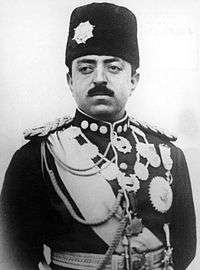
Following the decline of the Durrani dynasty and the establishment of the new Barakzai dynasty in Afghanistan, the Pashtun domains began to shrink as they lost control over other parts of South Asia to the British, such as the Punjab region and the Balochistan region. The Anglo-Afghan Wars were fought as part of the overall imperialistic Great Game that was waged between the Russian Empire and the British. Poor and landlocked, newly born Afghanistan was able to defend its territory and keep both sides at bay by using them against each other. In 1893, as part of a way for fixing the limit of their respective spheres of influence, the Durand Line Agreement was signed between Afghan "Iron" Amir Abdur Rahman and British Viceroy Mortimer Durand. In 1905, the North-West Frontier Province (today's Khyber Pakhtunkhwa) was created and roughly corresponded to Pashtun majority regions within the British domain. The FATA area was created to further placate the Pashtun tribesmen who never fully accepted British rule and were prone to rebellions, while the city of Peshawar was directly administered as part of a British protectorate state with full integration into the federal rule of law with the establishment of civic amenities and the construction of railway, road infrastructure as well as educational institutes to bring the region at par with the developed world.
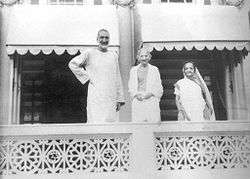
During World War I, the Afghan government was contacted by the Ottoman Turkey and Germany, through the Niedermayer-Hentig Mission, to join the Central Allies on behalf of the Caliph in a Jihad; some revolutionaries, tribals, and Afghan leaders including a brother of the Amir named Nasrullah Khan were in favour of the delegation and wanted the Amir to declare Jihad. Kazim Bey carried a firman from the Khalifa in Persian. It was addressed to "the residents of Pathanistan." It said that when the British were defeated, "His Majesty the Khalifa, in agreement with allied States, will acquire guarantee for independence of the united state of Pathanistan and will provide every kind of assistance to it. Thereafter, I will not allow any interference in the country of Pathanistan." (Ahmad Chagharzai; 1989; pp. 138–139). However the efforts failed and the Afghan Amir Habibullah Khan maintained Afghanistan's neutrality throughout World War I.[45]
Similarly, during the 1942 Cripps mission, and 1946 Cabinet Mission to India, the Afghan government made repeated attempts to ensure that any debate about the independence of India must include Afghanistan's role in the future of the NWFP. The British government wavered between reassuring the Afghan to the rejection of their role and insistence that NWFP was an integral part of British India.[46]
During World War II, the government of Nazi Germany proposed an alliance with neutral Afghanistan in order to destabilize British control over the northwest of its domain in India. In return, the Afghans sought that NWFP and the Port of Karachi would be ceded to the Kingdom of Afghanistan with German military aid, so that it could gain valuable access to the Arabian Sea.[47] Such a plan would require annexation of NWFP, Baluchistan and Sindh provinces.
The Khudai Khidmatgars (also known as the "Red Shirts") were members of a civil rights movement. Its leader Bacha Khan claimed to have been inspired by the Indian activist Mahatma Gandhi. While the Red Shirts were willing to work with the Indian National Congress from a political point of view, the Pashtuns living in the NWFP desired independence from India. However, the Bacha Khan wanted the Pashtuns areas in British India to remain part of United India instead of gaining independence.
Bannu Resolution
In June 1947, Mirzali Khan (Faqir of Ipi), Bacha Khan, and other Khudai Khidmatgars declared the Bannu Resolution, demanding that the Pashtuns be given a choice to have an independent state of Pashtunistan composing all Pashtun majority territories of British India, instead of being made to join the new state of Pakistan.[48] However, the British Raj refused to comply with the demand of this resolution.[49][50]
1947 NWFP referendum
The NWFP joined the Dominion of Pakistan as a result of the 1947 NWFP referendum, which had been boycotted by the Khudai Khidmatgar movement, including Bacha Khan and then-chief minister Dr. Khan Sahib, as the options of forming Pashtunistan or joining Afghanistan were not given in the referendum. Out of the total population of 4 million in the NWFP, 572,798 were eligible to vote, of whom 51.00% voted in the referendum. 289,244 (99.02%) of the votes were cast in favor of Pakistan and only 2,874 (0.98%) in favor of India.[20][21][51][52]
Independence of Pakistan in 1947
The concept of Pashtunistan has varying meanings across Pakistan and Afghanistan.[53] In Afghanistan, Pashtun nationalists look after the interests of the Pashtun ethnic group and have support only from them.[54] They favor the ideas of Lōy Afghānistān or "Greater Afghanistan", and maintain an irredentist claim on the entire Pashtun-populated region.[54][55] The Pashtunistan demand also served the cause of domestic Afghan politics, where several successive governments used the idea to strengthen "Pashtun ethnic support" for the state. This policy intensified ethno-linguistic rivalry between Pashtuns and non-Pashtuns in the country.[53] These claims are contested in Pakistan, where Pashtun politics centres on political autonomy rather than irredentist politics.[27]
Since the late 1940s with the dissolution of British India and independence of Pakistan, some rigid Pashtun nationalists proposed merging with Afghanistan or creating Pashtunistan as a future sovereign state for the local Pashtun inhabitants of the area. At first, Afghanistan became the only government to oppose the entry of Pakistan into the United Nations in 1947, although it was reversed a few months later. On July 26, 1949, when Afghanistan–Pakistan relations were rapidly deteriorating, a loya jirga was held in Afghanistan after a military aircraft from the Pakistan Air Force bombed a village on the Afghan side of the Durand Line. As a result of this violation, the Afghan government declared that it recognized "neither the imaginary Durand nor any similar line" and that all previous Durand Line agreements were void.[56] Bacha Khan when took an oath of allegiance to Pakistan in 1948 in legislation assembly and during his speech he was asked by PM Liaquat Ali Khan about Pashtunistan to which he replied that it's just a name to the Pashtun province in Pakistan same like Punjab, Bengal, Sindh and Baluchishtan are the names of provinces of Pakistan as ethno-linguistic names,[57] contrary to what he believed and strived for Pashtunistan an independent state. During the 1950s to the late 1960s, Pashtuns were promoted to higher positions within the Pakistani government and military, thereby integrating Pashtuns into the Pakistani state and severely weakening secessionist sentiments to the point that by the mid-1960s, popular support for an independent Pashtunistan had all but disappeared.
An important development in Pakistan during the Ayub period (1958–1969) was the gradual integration into Pakistani society and the military-bureaucratic establishment. It was a period of Pakistan's political history which saw a large number of ethnic Pashtuns holding high positions in the military and the bureaucracy. Ayub himself was a non-Pashto speaking ethnic Pashtun belonging to the Tarin sub-tribe of the Hazara district in the Frontier. The growing participation of Pashtuns in the Pakistani Government resulted in the erosion of the support for the Pashtunistan movement in the Province by the end of the 1960s.[27]
— Rizwan Hussain, 2005
Afghanistan and Pashtun nationalists did not exploit Pakistan's vulnerability during the nation's 1965 and 1971 wars with India, and even backed Pakistan against a largely Hindu India. Further, had Pakistan been destabilised by India, nationalists would have had to fight against a much bigger country than Pakistan for their independence.[58]
Sardar Daoud Khan, who was the-then prime minister of Afghanistan supported a nationalistic reunification of the Pashtuns in Pakistan with Afghanistan. He wanted Pashtun dominated areas like Khyber Pakhtunkhwa and Baloch dominated areas like Balochistan to become part of Afghanistan. However, his policy of reunification of Pashtuns antagonized Non-Pashtuns like Tajiks, Uzbeks and Hazaras living in Afghanistan. Non-Pashtuns believed that the aim of reunification of Pashtuns areas was to increase the population of Pashtuns in Afghanistan. As a result, Daoud Khan was extremely unpopular with Non-Pashtun Afghans.[59] Similarly, Daoud Khan also failed to gain any support from Pashtuns in Pakistan. Baloch tribes in Pakistan also wondered why Daoud Khan had included Balochistan as part of his idea without their approval.[60][61] Bacha Khan stated that "Daoud Khan only exploited the idea of reunification of Pashtun people to meet his own political ends".[62] In 1960 and later in 1961, Daoud Khan made two attempts to capture Bajaur District in Khyber Pakthunkhwa, Pakistan. However, all of Daoud Khan attempts failed as Afghan army was routed with heavy casualties. Several Afghan army soldier were also captured by Pakistani soldiers and they were paraded in front of international media which in turn caused embarrassment for Daoud Khan.[60] As a consequence of Daoud Khan's actions, Pakistan closed its border with Afghanistan which turn caused economic crisis in Afghanistan. Because of continued resentment against Daoud's autocratic rule, close ties with the Soviet union and economic downturn caused of blockade imposed by Pakistan, Daoud Khan was forced to resign by King Zahir Shah.[60] Under King Zahir Shah rule, relations between Pakistan and Afghanistan improved and Pakistan opened its border with Afghanistan. However, later on in 1973, Daoud Khan seized power from King Zahir Shah in a military Coup d'état and declared himself the first president of Afghanistan. After seizing the power, the Daoud Khan's government started proxy war against Pakistan. Daoud Khan's government established several training camps for anti-Pakistani militants in Kabul and Kandahar with the aim of training and arming those militants to carry out their activities against Pakistan.[63]
The Pakistani government decided to retaliate against the Afghan government's Pashtunistan policy by supporting Non-Pashtun opponents of the Afghan government including future Mujahidin leaders like Gulbuddin Hekmatyar and Ahmad Shah Massoud.[64] This operation was remarkably successful, and by 1977 the Afghan government of Daoud Khan was willing to settle all outstanding issues in exchange for a lifting of the ban on the National Awami Party and a commitment towards provincial autonomy for Pashtuns, which was already guaranteed by Pakistan's Constitution, but stripped by the Bhutto government when the One Unit scheme was introduced.
Bacha Khan who previously strived greatly for Pashtunistan later on in 1980 during an interview with an Indian journalist, Haroon Siddiqui said that the "idea of Pashtunistan never helped Pashtuns. In fact it was never a reality". He further said that "successive Afghan governments have exploited the idea for their own political ends". It was only towards the end of Mohammed Daoud Khan regime that he stopped talking about Pashtunistan. Later on, even Nur Muhammad Taraki also talked about the idea of Pashtunistan and caused trouble for Pakistan. He also said that "Pashtun people greatly suffered because of all this."[62]
In 1976, the then president of Afghanistan, Sardar Mohammed Daoud Khan recognised Durand Line as international border between Pakistan and Afghanistan. He made this declaration while he was on an official visit to Islamabad, Pakistan.[65][66][67]
Following the outbreak of the Soviet-Afghan War in Afghanistan, millions of Afghans including non-Pashtun people fled to eastern end of Pashtunistan region.[68]
21st century

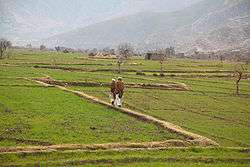
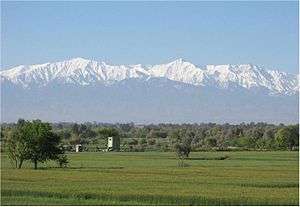
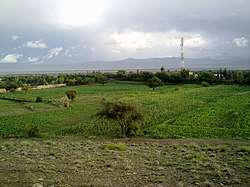
The Pashtunistan issue is rarely mentioned anymore as a point of disagreement between Afghan and Pakistan officials – a far cry from the 1950s and 1960s when the issue was considered contentious. There are several arguments from the governments of Afghanistan and Pakistan regarding the Pashtunistan issue.[70]
The British influence in the region of Afghanistan and Pakistan was most prominent during the late 19th century and early portion of the 20th century, when the British sought to reestablish efforts at colonization during Britain's imperial century. This British experiment was known as The Great Game, and was a subversive attempt at establishing Afghanistan as a buffer zone between British-India and the Tsardom of Russia. By seeking to accord certain terrain international legitimacy based upon British failures to assert control over the fiercely independent Pashtuns and tribes in the region, the establishment of a border that would separate British interests from tribal interests was extremely important to British foreign policy.
The British demarcation established as a result by the Durand Line was a deliberate strategy designed to divide the Pashtun territory along the border region of Afghanistan and Pakistan. The overall effect of the division was to alienate the Pashtun tribes from their neighbors as part of the British divide and rule strategy. This strategy had the ultimate effect of fostering anti-colonialist sentiment in the tribal regions, and Pashtuns as a result had a deep desire for independence and freedom from British rule.[71]
Pashtuns in Pakistan make up the second largest ethnic group after Punjabis with about 16% of the population, totaling over 30 million. This figure only includes the native Pashto speaking inhabitants of Khyber Pakhtunkhwa and Northern Balochistan, and does not include the Pathans settled in Punjab and Sindh who make up significant numbers alongside the native communities of these two provinces.[1] In addition, there are 1.7 million Afghan refugees of whom majority are Pashtuns. These refugees, however, are expected to leave Pakistan and settle in Afghanistan in the coming years. Three Pakistani presidents belonged to the Pashtun ethnic group. Pashtuns continue to occupy important places in the military and politics, with the current Prime Minister of Pakistan Imran Khan who leads Pakistan Tehreek-e-Insaf (PTI) and Awami National Party led by Asfandyar Wali . In addition to this, some Pashtun media, music and cultural activities are based out of Pakistan, with AVT Khyber being a Pashto TV channel in Pakistan. Pashto cinema is based out of the Pakistani city of Peshawar. The Pakistani city of Karachi is believed to host the largest concentration of Pashtuns.
There are more than 12 million Pashtuns in Afghanistan, constituting 42% of the population. Other sources say that up to 60% of Afghanistan's population is made up of ethnic Pashtuns, forming the largest ethnic group in that country. Pashto is the one of the official languages of Afghanistan,[72] the Afghan National Anthem is recited in Pashto language and the Pashtun dress is the national dress of Afghanistan. Since the late 19th century, the traditional Pashtunistan region has gradually expanded to the Amu River in the north. Many key government positions in Afghanistan have historically been held by Pashtuns. However, Pashtuns in Afghanistan don't occupy major positions in Afghan Armed Forces and Afghan Armed Forces continue to be dominated by Non-Pashtuns.[73] Many of the non-Pashtun groups in Afghanistan have adopted the Pashtun culture and use Pashto as a second language . For example, nearly all leaders of non-Pashtun ethnic groups in Afghanistan practice Pashtunwali to some degree and are fluent in Pashto language. This includes prominent non-Pashtun figures such as Ahmad Shah Massoud, Ahmad Zia Massoud, Ismail Khan, Mohammed Fahim, Bismillah Khan Mohammadi, Atta Muhammad Nur, Abdul Ali Mazari, Karim Khalili, Husn Banu Ghazanfar, Muhammad Yunus Nawandish, Abdul Karim Brahui, Jamaluddin Badr as well as most other ministers, governors and officials.
The majority of the Afghan Taliban[74] are ethnic Pashtuns,[75] with past Pashtun leaders such as Mullah Mohammed Omar, Mohammad Rabbani and Jalaluddin Haqqani. The current leaders of the Taliban include Pashtuns such as Abdul Kabir, Hibatullah Akhundzada and Sirajuddin Haqqani.
Afghanistan makes its claim on the Pashtun areas on the ground that it served as the Pashtun seat of power since 1709 with the rise of the Hotaki dynasty followed by the establishment of the Durrani Afghan Empire. According to historic sources, Afghan tribes did not appear in Peshawar valley until after 800 AD, when the Islamic conquest of this area took place.[76]
Agreements cited by the Afghan government as proof of their claim over the Pashtun tribes include Article 11 of the Anglo-Afghan Treaty of 1921, which states: "The two contracting parties, being mutually satisfied themselves each regarding the goodwill of the other and especially regarding their benevolent intentions towards the tribes residing close to their respective boundaries, hereby undertake to inform each other of any future military operations which may appear necessary for the maintenance of order among the frontier tribes residing within their respective spheres before the commencement of such operations."[77] A supplementary letter to the Anglo-Afghan Treaty of 1921 reads: "As the conditions of the Frontier tribes of the two governments are of interest to the Government of Afghanistan. I inform you that the British government entertains feelings of goodwill towards all the Frontier tribes and has every intention of treating them generously, provided they abstain from outrages against the people of India."[77]
The Durand Line and Pashtunistan issues have been raised by different Afghan regimes in the past. However, it may no longer be a concern. Pashtuns are now so well integrated in Pakistani society that the majority will never opt for Pashtunistan or Afghanistan. Afghan-Pashtun refugees have been staying in Khyber Pakhtunkhwa for more than 30 years. Threat perceptions about Afghanistan need re-evaluation so that suitable changes are made in our Afghan policy.[78]
— Asad Munir, Retired brigadier who has served in senior intelligence postings in Khyber-Pakhtunkhwa and FATA
Khyber Pakhtunkhwa
Prominent 20th century proponents of the Pashtunistan cause have included Khan Abdul Wali Khan and Khan Abdul Ghaffar Khan. Ghaffar Khan stated in the Pakistan Constituent Assembly in 1948 that he simply wanted "the renaming of his province as Pashtunistan same like Punjab, Bengal, Sindh and Baluchishtan are the names of provinces of Pakistan as ethno-linguistic names,[79] Another name mentioned is Afghania where the initial "A" in Choudhary Rahmat Ali Khan's theory stated in the "Now or Never" pamphlet stands for the second letter in "Pakistan". However, this name has failed to capture political support in the province.
There was support, however, to rename North-West Frontier Province (NWFP) as Pakhtunkhwa (which translates as "area of Pashtuns"). Nasim Wali Khan (the wife of Khan Abdul Wali Khan) declared in an interview: "I want an identity. I want the name to change so that Pathans may be identified on the map of Pakistan..."[80]
On 31 March 2010, Pakistan's Constitutional Reform Committee agreed that the province be named and recognized as Khyber-Pakhtunkhwa.[81][82] This is now the official name for the former NWFP.
Gallery
- Images of the Pashtunistan region
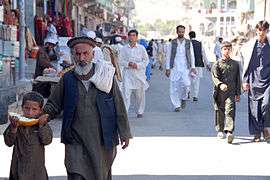 Asadabad, capital of Kunar Province in Afghanistan
Asadabad, capital of Kunar Province in Afghanistan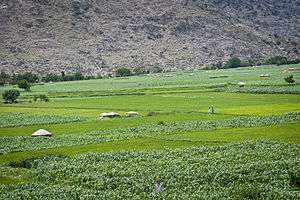 Pech River Valley
Pech River Valley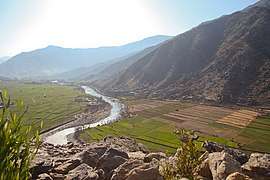 Watapur District of Kunar Province
Watapur District of Kunar Province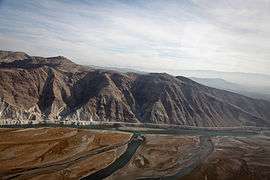 Branches of the Kunar River meet in Nangarhar Province
Branches of the Kunar River meet in Nangarhar Province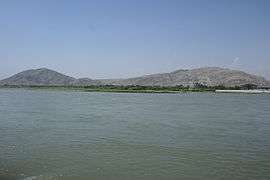 Kabul River in Jalalabad, Afghanistan
Kabul River in Jalalabad, Afghanistan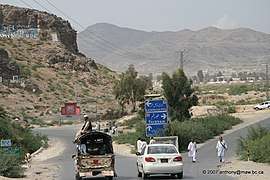 Khyber Pass in Khyber Pakhtunkhwa, Pakistan
Khyber Pass in Khyber Pakhtunkhwa, Pakistan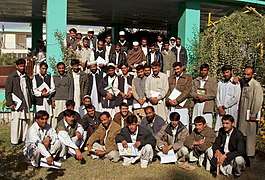 People attending Khost University in Khost, Afghanistan
People attending Khost University in Khost, Afghanistan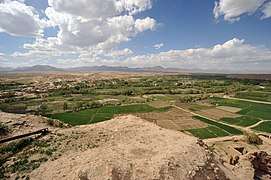 Ghazni Province, Afghanistan
Ghazni Province, Afghanistan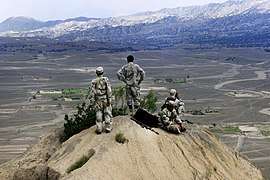 Afghan Border Police (ABP) in Paktika Province
Afghan Border Police (ABP) in Paktika Province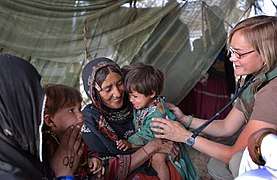 Kuchi people in Paktia Province of Afghanistan
Kuchi people in Paktia Province of Afghanistan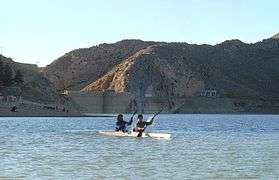 Hanna Lake in Quetta, Pakistan
Hanna Lake in Quetta, Pakistan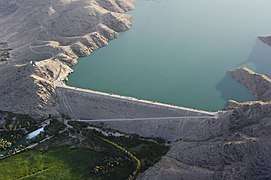
 Helmand Province, Afghanistan
Helmand Province, Afghanistan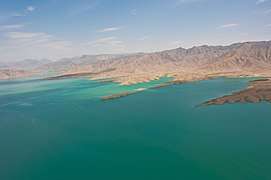 Kajaki Dam in Helmand Province
Kajaki Dam in Helmand Province
See also
References
- "Pakistan population: 187,342,721 [Pashtun (Pathan) 15.42%]". The World Factbook. Central Intelligence Agency (CIA). 2011. Retrieved 2012-02-10.
- "Afghanistan population: 30,419,928 (July 2012 est.) [Pashtun 42%] = 12,776,369". The World Factbook. Central Intelligence Agency (CIA). Retrieved 20 September 2010.
- Lewis, Paul M. (2009). "Pashto, Northern". SIL International. Dallas, Texas: Ethnologue: Languages of the World, Sixteenth edition. Retrieved 18 September 2010.
Ethnic population: 49,529,000 possibly total Pashto in all countries.
- Students' Britannica India. 1–5. Encyclopædia Britannica. 2000. ISBN 9780852297605.
Ghaffar Khan, who opposed the partition, chose to live in Pakistan, where he continued to fight for the rights of the Pashtun minority and for joining Afghanistan. Afghanistan means literally land of the pashtun people! the Homeland of the Pashtuns is Afghanistan
- The Modern Review, Volume 86. Prabasi Press Private. 1949.
The Afghan Government is actively sympathetic towards their demand for a Pathanistan. It has been declared by the Afghan Parliament that Afghanistan does not recognise the Durand line...
- The Spectator. 184. F.C. Westley. 1950.
Instead it adopted the programme of an independent "Pathanistan" — a programme calculated to strike at the very roots of the new Dominion. More recently the Pathanistan idea has been taken up by Afghanistan.
- Various spellings result from different pronunciation in various Pashto dialects. See Pashto language: Dialects for further information.
- Nath, Samir (2002). Dictionary of Vedanta. Sarup & Sons. p. 273. ISBN 81-7890-056-4. Retrieved 2010-09-10.
- "The History of Herodotus Chapter 7". Translated by George Rawlinson. The History Files. Retrieved 2007-01-10.
- Houtsma, Martijn Theodoor (1987). E.J. Brill's first encyclopaedia of Islam, 1913-1936. 2. Leipzig: BRILL. p. 150. ISBN 90-04-08265-4. Retrieved 2010-09-24.
- "Afghan and Afghanistan". Abdul Hai Habibi. alamahabibi.com. 1969. Retrieved 2010-10-24.
- Muhammad Qasim Hindu Shah (1560). "The History of India, Volume 6, chpt. 200, Translation of the Introduction to Firishta's History (p.8)". Sir H. M. Elliot. London: Packard Humanities Institute. Archived from the original on 2013-07-26. Retrieved 2010-08-22.
- Dan Caldwell (17 February 2011). Vortex of Conflict: U.S. Policy Toward Afghanistan, Pakistan, and Iraq. Stanford University Press. p. 36. ISBN 978-0-8047-7666-0.
A majority of Pashtuns live south of the Hindu Kush (the 500-mile mountain range that covers northwestern Pakistan to central and eastern Pakistan) and with some Persian speaking ethnic groups. Hazaras and Tajiks live in the Hindu Kush area, and north of the Hindu Kush are Persians and Turkic ethnic groups.
- "Controversial Proposal Of 'Pashtunistan'". RadioFreeEurope/RadioLiberty.
- Shane, Scott (5 December 2009). "The War in Pashtunistan". The New York Times. Retrieved 2 October 2017.
- "Abdul Ghaffar Khan". Encyclopædia Britannica. Retrieved 24 September 2008.
- "Abdul Ghaffar Khan". I Love India. Retrieved 24 September 2008.
- Qasmi, Ali Usman; Robb, Megan Eaton (2017). Muslims against the Muslim League: Critiques of the Idea of Pakistan. Cambridge University Press. p. 2. ISBN 9781108621236.
- "Partition and Military Succession Documents from the U.S. National Archives".
- Electoral History of NWFP (PDF). Archived from the original (PDF) on 10 August 2013.
- Michael Brecher (2017-07-25). A Century of Crisis and Conflict in the International System: Theory and Evidence: Intellectual Odyssey III. Springer. ISBN 9783319571560. Retrieved 25 July 2017.
- Meyer, Karl E. (2008-08-05). The Dust of Empire: The Race For Mastery In The Asian Heartland – Karl E. Meyer – Google Boeken. ISBN 9780786724819. Retrieved 10 July 2013.
- "Was Jinnah democratic? — II". Daily Times. December 25, 2011. Retrieved February 24, 2019.
- "Everything in Afghanistan is done in the name of religion: Khan Abdul Ghaffar Khan". India Today. Archived from the original on 8 January 2019. Retrieved 13 January 2014.
- The Faqir of Ipi of North Waziristan. The Express Tribune. November 15, 2010.
- The legendary guerilla Faqir of Ipi unremembered on his 115th anniversary. The Express Tribune. April 18, 2016.
- Rizwan Hussain. Pakistan and the emergence of Islamic militancy in Afghanistan. 2005. p. 74.
- https://www.geo.tv/latest/225799-the-fata-merger-whats-happening-now-and-what-should-happen-next
- Faultlines, Volume 18. Institute for Conflict Management. 2007. p. 59.
The name Pakhtunistan or in soft Pashtu dialect Pashtunistan evolved originally from the Indian word Pathanistan. The very concept of Pakhtunistan was taken from the old word Pakhtunkhwa. Obaidullah Sindhi used Pashtania for Pashtu speaking area of his Proposed People's Republic of India or Saro-Rajia-i-Hind (Obaidullah's letter to Iqbal Shaidai on 22 June 1924), Muhammad Aslam, Maulana Obaidullah Sindhi Kay Siasi Maktubat, Lahore: Niduatal Musanifeen, 1966, p. 34
- "Pashtu Literature Part II". Pashtoonkhwa. Retrieved 2009-06-07.
The name Pakhtunistan or in soft Pashtu dialect Pashtunistan evolved originally from the Indian word Pathanistan. The very concept of Pakhtunistan was taken from the old word Pakhtunkhwa. The British, Indian leaders and even the Khudai- Khidmatgars were using Pathanistan for Pakhtunistan in the beginning, but later on they started using the word Pakhtunistan.
- "The Problem of Pukhtunistan". Khyber Gateway. Retrieved 2009-06-07.
The word Pathanistan is not Persian but Indian. It shows that the Khalifa had already acquired the consent of the Muslim leaders of India or these leaders might have motivated the Khalifa to first liberate the Pukhtuns' land (Pathanistan) to build up a strong base against the British Empire in India
- Ahmed, Feroz (1998) Ethnicity and politics in Pakistan. Karachi. Oxford University Press.
- Janda, Kenneth; Jeffrey M. Berry; Jerry Goldman (2008). The Challenge of Democracy: Government in America (9 ed.). Cengage Learning. p. 46. ISBN 978-0-618-81017-8. Retrieved 2010-08-22.
Even within the largest ethnic group, the Pashtuns (about 50 percent of the population)...
- Congressional Record. Government Printing Office. 1955. p. 10088. Retrieved 2010-09-24.
- Taylor, William J. Jr.; Abraham Kim (2000). Asian Security to the Year 2000. DIANE Publishing. p. 58. ISBN 1-4289-1368-8. Retrieved 2010-09-24.
- "AFGHANISTAN v. Languages". Ch. M. Kieffer. Encyclopædia Iranica. Retrieved 2010-10-24.
Paṧtō (1) is the native tongue of 50 to 55 percent of Afghans...
- Brown, Keith; Sarah Ogilvie (2009). Concise encyclopedia of languages of the world. Elsevie. p. 845. ISBN 978-0-08-087774-7. Retrieved 2010-09-24.
Pashto, which is mainly spoken south of the mountain range of the Hindu Kush, is reportedly the mother tongue of 60% of the Afghan population.
- Hawthorne, Susan; Bronwyn Winter (2002). September 11, 2001: feminist perspectives. Spinifex Press. p. 225. ISBN 1-876756-27-6. Retrieved 2010-09-24.
Over 60 percent of the population in Afghanistan is Pashtun...
- "Pakistan Census report 1998". Government of Pakistan. 1998. Archived from the original on 2011-09-12. Retrieved 2010-10-29.
- "Country Profile: Afghanistan" (PDF). Library of Congress. Library of Congress Country Studies on Afghanistan. August 2008. Retrieved 2010-09-10.
- "Kingdoms of South Asia – Afghanistan (Southern Khorasan / Arachosia)". The History Files. Retrieved 2010-08-16.
- John Ford Shroder. "Afghanistan – VII. History". Archived from the original on October 31, 2009. Retrieved 2009-10-31.
- "You are being redirected..." www.astrojyoti.com.
- Misra, Amalendu (30 August 2004). Identity and Religion: Foundations of Anti-Islamism in India. SAGE Publications. ISBN 9780761932260 – via Google Books.
- http://khyberwatch.com/ Archived 2007-10-07 at the Wayback Machine
- Roberts, J(2003) The origins of conflict in Afghanistan. Greenwood Publishing Group, ISBN 0-275-97878-8, ISBN 978-0-275-97878-5, pp. 92-94
- Hauner, Milan L. (1982). "Afghanistan between the Great Powers, 1938 - 1945". International Journal of Middle East Studies. 14 (4): 481–499. doi:10.1017/S002074380005217X. ISSN 0020-7438. JSTOR 162977.
- "Past in Perspective". The Nation. August 25, 2019. Retrieved August 25, 2019.
- Ali Shah, Sayyid Vaqar (1993). Marwat, Fazal-ur-Rahim Khan (ed.). Afghanistan and the Frontier. University of Michigan: Emjay Books International. p. 256.
- H Johnson, Thomas; Zellen, Barry (2014). Culture, Conflict, and Counterinsurgency. Stanford University Press. p. 154. ISBN 9780804789219.
- "Archived copy" (PDF). Archived from the original (PDF) on 10 August 2013. Retrieved 2013-12-28.CS1 maint: archived copy as title (link)
- Jeffrey J. Roberts (2003). The Origins of Conflict in Afghanistan. Greenwood Publishing Group. pp. 108–109. ISBN 9780275978785. Retrieved 18 April 2015.
- Barnett R. Rubin (25 March 2015). Afghanistan from the Cold War Through the War on Terror. Oxford University Press. pp. 367–. ISBN 978-0-19-022927-6.
- Zalmay Khalilzad, "The Security of Southwest Asia", University of Michigan, 2006, ISBN 0-566-00651-0
- Caron, James M (2009). Cultural Histories of Pashtun Nationalism, Public Participation, and Social Inequality in Monarchic Afghanistan, 1905-1960.
- The Pashtunistan Issue, Craig Baxter (1997), Library of Congress Country Studies.
- Bukhari, Farigh (1991). Taḥrīk-i āzādī aur Bācā K̲h̲ān. Fiction House. p. 226.
- Paul Wolf. "Pashtunistan." Pakistan: Partition and Military Succession. 2004.
- Saeedi, Sayed Ziafatullah (7 November 2018). "Daoud's Footprints: how Afghanistan's First President Influences Ghani". The Globe Post. Retrieved 1 March 2019.
- Tomsen, Peter (2013). The Wars of Afghanistan:Messianic Terrorism, Tribal Conflict, and the Failures of Great Powers. Hachette UK. ISBN 9781610394123.
- Arbabzadah, Nushin (21 March 2009). "Nushin Arbabzadah: Sardar Daud Khan remembered" – via www.theguardian.com.
- "Everything in Afghanistan is done in the name of religion: Khan Abdul Ghaffar Khan". India Today. Retrieved 13 January 2014.
- Venkataramakrishnan, Rohan (19 May 2013). "Send Section 66A bullies home". India Today. Retrieved 24 October 2016.
- "Remembering Our Warriors: Babar 'the great'." Interview of Maj. Gen. (Retd.) Naseerullah Khan Babar, by A. H. Amin. Defence Journal. April 2001. Retrieved 15 April 2010.
- Rasanayagam, Angelo (2005). Afghanistan: A Modern History. I.B. Tauris. p. 64.
- Dorronsoro, Gilles (2005). Revolution Unending: Afghanistan, 1979 to present. Hurst & Co. Publisher. p. 84. ISBN 9781850656838.
- Nunan, Timothy (2016). Humanitarian Invasion: Global Development in Cold War Afghanistan. Cambridge University Press. p. 125. ISBN 9781107112070.
- Bajoria, Jayshree (20 March 2009). "The Troubled Afghan-Pakistani Border". Council on Foreign Relations. Archived from the original on 25 May 2010. Retrieved 11 February 2011.
- "Punja Sahib: The Miracle at Hassan Abdal". Wonders of Pakistan. Retrieved 6 May 2016.
- Feroz Ahmed. "Pushtoonistan and the Pushtoon National Question." (Sep., 1973) Pakistan Forum, Vol. 3, No. 12. September 1973. pp. 8-19+22.
- Senlis Afghanistan-http://www.icosgroup.net/modules/reports/Afghanistan_on_the_brink: Retrieved 23 December 2010
- "Article Sixteen of the 2004 Constitution of Afghanistan". 2004. Retrieved June 13, 2012.
From among the languages of Pashto, Dari, Uzbeki, Turkmani, Baluchi, Pashai, Nuristani, Pamiri (alsana), Arab and other languages spoken in the country, Pashto and Dari are the official languages of the state.
- "Afghan Army Struggles With Ethnic Divisions". CBS News. July 27, 2010.
Despite ethnic quotas and recruiting drives, the Afghan army is still dominated by northern minorities who were oppressed by the Taliban. Nearly all Taliban are ethnic Pashtuns.
- "Afghan government continues to lose ground to Taliban: SIGAR". www.aljazeera.com. Retrieved 2019-04-10.
- Decoding the new Taliban : insights from the Afghan field. Giustozzi, Antonio. New York: Columbia University Press. 2009. ISBN 9780231701129. OCLC 318971971.CS1 maint: others (link)
- H. G. Raverty (1898) Tarikh-e-Farishtah; Notes on Afghanistan; Peshawar District Gazetteer 1897-98.
- Olaf Caroe. The Pathans 1981.
- "Re-evaluation of our Afghan policy". Express Tribune. 15 May 2012. Retrieved 16 May 2012.
- Bukhari, Farigh (1991). Taḥrīk-i āzādī aur Bācā K̲h̲ān. Fiction House. p. 226.
- Jaffrelot, Christophe (2002). A History of Pakistan and Its Origins. Anthem Press. p. 312. ISBN 1843310309.
- BBC News Online – Pakistan debates key amendment bill Retrieved 5 April 2010
- Dawn News – Consensus reached on renaming NWFP Retrieved 5 April 2010
Further reading
- Ahmed, Feroz (1998) Ethnicity and politics in Pakistan. Karachi: Oxford University Press.
- Ahmad, M.(1989) Pukhtunkhwa Kiyun Nahin by Mubarak Chagharzai. pp. 138–139.
- Amin, Tahir (1988) -National Language Movements of Pakistan. Islamabad Institute of Policy Studies.
- Buzan, Barry and Rizvi, Gowher (1986), South Asian Insecurity and the Great Powers, London: Macmillan. p. 73.
- Fürstenberg, Kai (2012) Waziristan: Solutions for a Troubled Region in Spotlight South Asia, No. 1, ISSN 2195-2787 (https://web.archive.org/web/20150907205431/http://www.apsa.info/wp-content/uploads/2012/10/SSA-1.pdf)
- Caroe, Olaf (1983) The Pathans, with an Epilogue on Russia. Oxford University Press. pp. 464–465.